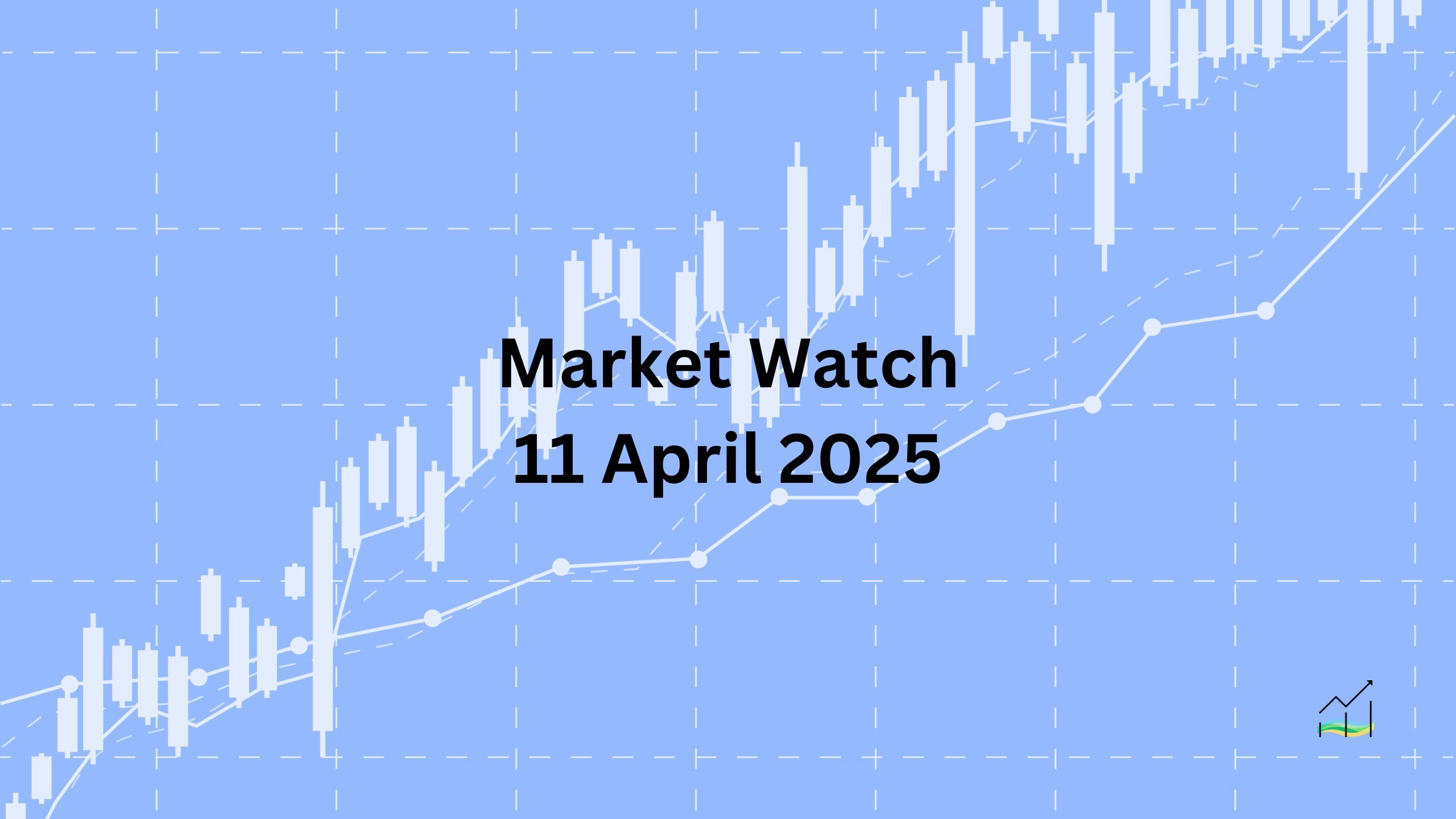11/04/2025 Market Watch

Markets Whipsawed as Trade Tensions Escalate, Safe-Havens Surge
Key Takeaways:
- US-China trade war escalates with tariff hikes from both sides.
- Equity markets see wide divergence: Asia mixed, US gains, Europe weak.
- Bond yields reflect economic divergence, with UK yields rising and JGBs falling.
- Dollar under pressure, with Swiss franc and NZD leading gains.
- Gold hits record high, oil continues to slide.
The trade war between the US and China has intensified, causing fresh disruption in global markets. After initially announcing a 125% tariff increase on Chinese goods, the US corrected itself, stating that the hike was in fact 145%. China quickly responded with its own countermeasure, raising tariffs on US goods to 125%. While the real impact of these hikes depends on how sensitive demand is for specific products, the broader effect is clear: most goods now face prices that make them uncompetitive. Further tariff escalations at this point appear largely symbolic.
This shift sent equity markets into a turbulent spin. Asia-Pacific equities were mixed, with gains seen in Hong Kong, mainland China, and Taiwan. However, the broader picture remains negative: mainland Chinese stocks listed in Hong Kong are down 7.3% for the week, while the Hang Seng and Taiwan’s composite have each fallen more than 8%. In contrast, Japan’s Topix has held up relatively well, dropping less than 1%. In Europe, the Stoxx 600 fell another 1.2% today, bringing the weekly loss to nearly 3%, on top of last week's 8.4% slide. US futures, surprisingly, have remained relatively steady. The S&P 500 is up about 3.5% on the week, while the Nasdaq has gained just over 5%.
Bond markets have painted a more mixed picture. The US 10-year Treasury yield has eased slightly to 4.40%, though it's still up by 22 basis points for the week. In the UK, stronger-than-expected GDP data pushed Gilt yields higher, with the 10-year rising four basis points today. Yields in the eurozone remained relatively flat, while Japan’s 10-year JGB yield dropped five basis points, trimming the week’s gain to 20 basis points.
The dollar has come under significant pressure, as market stress prompts a shift into other currencies. The Swiss franc leads the G10 pack with a 5% weekly gain, followed by the New Zealand dollar and the euro, each up 3.7%. Gold, acting as a haven amid the volatility, has surged to an all-time high near $3230 — a 6.3% gain this week. Meanwhile, oil prices remain under pressure. May WTI crude is holding near $60 a barrel, down nearly 2.75% this week after plunging over 10% last week.
United States of America
Overview
The pressure on US markets continues to broaden. After sharp declines in equities and bonds, the dollar is now under significant stress. Despite a temporary rebound, recession concerns, inflation pressures, and commodity shifts are steering sentiment. Key data releases ahead could further shape market expectations.
Economic Drivers
- Dollar Index fell nearly 3.8% this week, reaching a three-year low near 99.20.
- Recession fears are growing, compounded by weak equity and bond market performance.
- OPEC+ accelerating production cuts has driven oil down, easing inflation fears slightly.
- Inflation breakevens are relatively stable, indicating anchored long-term expectations.
- Retail gasoline prices remain firm despite the drop in crude.
Data and Events
- April 11 – March PPI report: Headline expected at 3.3% (prev 3.2%), Core at 3.6% (prev 3.4%).
- April 12 – University of Michigan Consumer Sentiment (Prelim April): Confidence expected to decline, with a possible uptick in inflation expectations.
Price Action
- Dollar Index dropped to 99.20, its lowest since 2022, before recovering to around 99.40.
- It touched three standard deviations below its 20-day moving average.
- May WTI crude fell nearly 24% from early April highs, now hovering near $55.
- Breakeven inflation rates: 2-year at ~3.10%, 10-year at ~2.16%, both easing from February highs.
Key Points:
- Dollar Index hits a three-year low, down nearly 3.8% this week.
- March PPI and Michigan survey in focus for inflation and sentiment signals.
- Oil prices down sharply but not yet reflected in retail fuel costs.
- Inflation breakevens show less concern despite rising short-term pressures.
Australia & New Zealand
Overview
Both the Australian and New Zealand dollars staged a strong recovery this week, driven by broader US dollar weakness. While momentum eased slightly by Friday, the rebound has been notable, with key technical levels reclaimed. Despite limited follow-through in the last session, gains remain substantial for the week.
Economic Drivers
- Weaker US dollar allowed both AUD and NZD to rebound strongly.
- Risk sentiment and improved technical outlook supported short-term rallies.
- Lack of strong domestic catalysts meant movement was largely driven by external pressures.
Data and Events
No major domestic economic releases scheduled.
Price Action
- AUD posted a bullish key reversal midweek and climbed to $0.6250, testing the 20-day moving average.
- Price pulled back slightly but closed above $0.6200 for the first time in five sessions.
- NZD outperformed, rising nearly 4% on the week and clearing the 61.8% retracement of its prior decline.
- NZD broke above $0.5765 resistance and touched $0.5815, firmly above its 20-day moving average (~$0.5715).
Key Points:
- AUD gained over 3% this week, though recent momentum has slowed.
- NZD rose nearly 4%, clearing key resistance and reclaiming trend indicators.
- Movement driven primarily by broad USD weakness, not domestic data.
- Both currencies remain technically strong heading into next week.
China
Overview
The yuan extended its recent decline, though the pace has been more controlled than expected despite rising trade tensions. With both the US and China escalating tariffs, the market watched closely for signs of a larger devaluation, which did not materialize. The offshore yuan slipped to new lows before rebounding modestly, while the onshore yuan also weakened but steadied by week's end.
Economic Drivers
- Ongoing US-China trade tensions escalated with US tariffs raised to 145% and China retaliating with 125% on US goods.
- Market speculation of a sharp yuan devaluation proved unfounded as Beijing managed a more stable response.
- PBOC allowed a slightly weaker fix but largely followed market moves, signaling a controlled approach to yuan management.
Data and Events
- April 12 – China retaliates with 125% tariffs on US goods (in response to updated US tariff clarification).
Price Action
- Offshore yuan (CNH) fell to nearly CNH7.29 after reaching a three-day low under CNH7.30, meeting the 61.8% retracement from the April 4 low to April 8 high.
- Rebounded sharply to around CNH7.2265.
- CNH still posted its fourth consecutive weekly decline, though this week’s loss was a modest 0.35%.
- Onshore yuan (CNY) declined by ~0.4%, unwinding recent gains and snapping a four-day greenback advance.
- PBOC fixed the yuan lower for the first time in seven sessions (CNY7.2087).
Key Points:
- Offshore yuan marked a fourth straight weekly loss, but only -0.35%.
- No aggressive devaluation from China despite tariff pressure.
- PBOC fix adjusted lower, following rather than leading market moves.
- Trade tensions remain high with tariff retaliation from both sides.
Europe
Overview
The euro staged a powerful breakout, surging to a three-year high and breaching several long-term resistance levels. The move was driven primarily by broad dollar weakness and technical momentum. While it pulled back slightly after touching fresh highs, the euro’s shift above long-term trend lines has caught market attention and raised questions about the sustainability of this rally.
Economic Drivers
- US dollar weakness provided a key catalyst for the euro’s upward move.
- Market focus turned to long-term equilibrium values, including purchasing power parity (PPP) and long-run averages.
- OECD’s PPP estimate pegs euro “fair value” at $1.46, significantly higher than current levels.
Data and Events
No major eurozone macroeconomic releases during this period.
Price Action
- Euro surpassed its 2024 high ($1.1215) and reached as high as $1.1475 before settling near $1.1360.
- This marked a new three-year high.
- Moved above its 10-year moving average (~$1.1170) for the first time since 2021.
- The 20-year moving average (~$1.2260) now becomes the next technical reference point.
Key Points:
- Euro surged to a three-year high at $1.1475 before pulling back to $1.1360.
- Cleared major resistance levels, including the 2024 and 10-year moving averages.
- Long-term reference levels suggest more upside potential if momentum continues.
- No major data releases this week; price action dominated by technicals and dollar weakness.
United Kingdom
Overview
Sterling advanced for a third straight session, briefly surpassing key retracement levels and approaching last week’s highs. Although the pound strengthened, it underperformed against other major currencies like the euro and Swiss franc. The stronger-than-expected February GDP report offered some support, though market reactions suggest broader FX trends and dollar weakness played a larger role.
Economic Drivers
- February GDP rose 0.5% (vs. 0.1% expected), recovering from January’s contraction.
- Industrial production jumped 1.5%, with manufacturing up 2.2%.
- Services sector expanded by 0.3%, and construction rebounded by 0.4%.
- Trade balance turned negative due to slower gold exports:
- Total deficit widened to ~GBP1.96 billion from a GBP301 million surplus.
- Excluding precious metals, the deficit was GBP783 million (previously a GBP537 million surplus).
Data and Events
- April 12 – February GDP report: +0.5% m/m vs. expected +0.1%.
- April 12 – Industrial and manufacturing production: Industrial +1.5%, Manufacturing +2.2%.
- April 12 – Trade balance: Shifted to deficit due to slowing gold exports.
Price Action
- Sterling rose to $1.3135, breaching the 61.8% retracement of the recent drop (from ~$1.3205 to $1.2710).
- Pulled back modestly to $1.3080 during late European trading.
- Last week’s high near $1.32 remains a key resistance level.
Key Points:
- GBP gained for the third session in a row but lagged euro and franc.
- February GDP and production data surprised to the upside.
- Trade deficit widened, especially when excluding precious metals.
- Sterling broke key retracement levels but faces resistance near $1.32.
© 2025 SKONE Enterprise (003319453-V). All rights reserved.
The content on this site is for informational purposes only and does not constitute financial advice.


